Risk of wheat bulb fly damage is highest since 2011

The risk of wheat bulb fly damage in winter cereals is the highest since 2011 with northern England being particularly vulnerable to attacks.
The late cereal harvest is likely to have encouraged the pest to lay more eggs, and a seed treatment is recommended for cereals drilled from November onwards, reported a survey by AHDB Cereals and Oilseeds.
See also: Warning of high wheat bulb fly pressure in North
Wheat bulb fly attacks all cereals (except oats) and the pest is most prevalent in eastern and north east England.
The pest lays its eggs in late summer in bare soil or between row of crops such as potatoes or sugar beet.
Winter cereals drilled in September and October are usually sufficiently well developed to resist the wheat bulb fly egg hatch in January/February, whereas those drilled in November/December are most at risk.
The survey, conducted by Adas for the AHDB, took soil samples from 30 fields, and one was at “very high risk” and four “high risk”, with all five sites above the spray threshold of 250 eggs/sq m.
Site above this threshold may benefit from an egg-hatch spray (chlorpyrifos) between the start of egg hatch in January and its peak in February or March.
Caroline Nicholls, AHDB research manager, said there are many factors influencing wheat bulb fly risk but it is possible that a late harvest could have had an effect this year.
“Where crops were cut late, it gave more time for fungi to develop in cereal ears and this provided a good food source for adult females helping them to mature more eggs,” she added.

